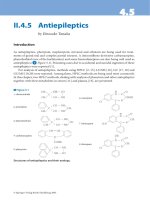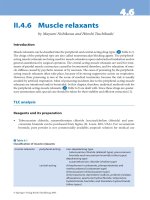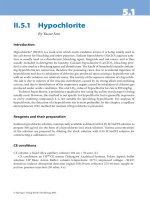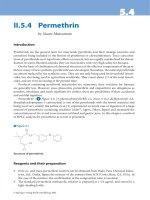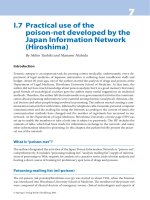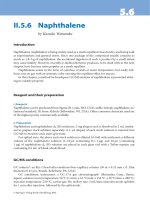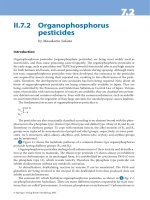Energy Storage in the Emerging Era of Smart Grids Part 7 pptx
Bạn đang xem bản rút gọn của tài liệu. Xem và tải ngay bản đầy đủ của tài liệu tại đây (4.2 MB, 30 trang )
v
ac,A
v
ac,B
ωt
i
k
ωt
ωt
ωt
V
A
V
B
-V
A
-V
A
+V
B
/n
V
A
+V
B
/n
V
A
-V
B
/n
-V
A
-V
B
/n
φ
v
Lk
=
v
ac,A
-v’
ac,B
0 π 2π
(a)
V
B
-V
B
v
ac,A
-V
A
v
ac,B
φ
ωt
i
k
ωt
ωt
ωt
-V
A
+V
B
/n
V
A
+V
B
/n
V
A
-V
B
/n
-V
A
-V
B
/n
0 π 2π
v
Lk
=
v
ac,A
-v’
ac,B
(b)
V
B
C
c
B
+
-
Q
5
Q
6
Q
7
Q
8
C
B
+
-
Q
3
Q
4
Q
1
Q
2
L
dc
V
A
Q
C
A
i
B
i
ac,B
i
ac,A
+
_
v
ac,A
v
ac,B
+
_
i
A
v
ac,A
Q
1
,Q
4
i
A
ωt
0 π 2π
ωt
ωt
Q
2
,Q
3
ωt
i
ac,A
ωt
(a)
v
ac,B
Q
5
,Q’
6
i
dc,B
ωt
0 π 2π
ωt
ωt
Q
8
,Q’
7
ωt
Q
1
,Q
4
Q
2
,Q
3
ωt
ωt
i
ac,B
(b)
B
+
-
C
4
C
3
+
-
Q
3
Q
4
Q
1
Q
2
V
A
Aux. Bus
L
K
i
A
i
B
i
K
v
ac,A
v
ac,B
+
_
+
_
C
2
C
1
L
dc
V
M
(a)
V’
B
+
-
C’
4
C’
3
+
-
Q
3
Q
4
Q
1
Q
2
V
A
Aux. Bus
L
K
i
A
i’
B
i
K
v
ac,A
v’
ac,B
+
_
+
_
C
2
C
1
L
dc
(b)
V1
-V2
v
ac,A
V3
-V4
v
ac,B
v
Lk
= v
ac,A
- v’
ac,B
φ
ωt
i
k
ωt
ωt
ωt
-V2+V4/n
V1+V4/n
V1-V3/n
-V2-V3/n
i
A
0 π 2π
(a)
V3
-V4
v
ac,A
V1
-V2
v
ac,B
φ
ωt
i
k
ωt
ωt
ωt
-V2+V4/n
V1+V4/n
V1-V3/n
-V2-V3/n
i
A
0 π 2π
v
Lk
=
v
ac,A
-v’
ac,B
(b)
dc-dc
converter
(BDC)
dc-ac
converter
Line
frequency
transformer
ac grid
Isolation
barrier
Energy
storage
Isolated
bidirectional
dc-dc converter
(IBDC)
dc-ac
converter
ac grid
Isolation
barrier
Energy
storage
Bi-Directional DC - DC Converters for
Battery Buffers with Supercapacitor
Jan Leuchter
University of Defence,
Czech Republic
1. Introduction
Sources of electrical energy for industry, agriculture or military use are different with
respect to the purpose, place, sort of appliance, type of supplied systems. Fixed military
facilities, for example, bases and camps are supplied by common electrical network system.
Uninterruptible power sources are used to span short network black-outs and to maintain
the power quality supplied to computers and other sensitive electronic equipment due to
dips, surges and voltage reductions (Kurka & Leuchter, 2008).
In vehicles and aircraft various types of accumulator batteries are used for starting of
engines, on-board generators as main source of electrical energy are driven by operating
engines. Stable electrical power generating sets are used for power supply in military bases
and camps, where the connection to network is not possible. Mobile generating sets are also
used for general use to supply various appliances, facilities, systems, for heating,
illumination, and other purposes in industry, agriculture or military units. Most of up to
date systems are equipped by specialized built-in generating sets. In studies focused on this
problem the sources based on the small nuclear generators, sun and wind energy are
speculated, but no one from these technologies is suitable from the mobility, safety and
operativity of corresponding application point of view. The majority of above mentioned
electrical energy sources use some means of energy accumulation (electrical energy buffers
or accumulators) to secure the reliable operation under all possible circumstances and
conditions. It is considered as self-evident that fuel cells become another mobile power
sources and electrical energy buffers (batteries). Fuel cells were marked as one of the new
energetic source alternatives for military applications. In the comparison with classical
conversion of fuel (where the efficiency reaches 15 to 35%, and with the gas turbine with
max. 40%), fuel cells based on the direct conversion of chemical energy to the electric one
reach efficiency 50 to 70%, according to the type, power, used chemicals and design. In the
combination with semiconductor converters, systems based on the fuel cells become
practically the universal source of electric energy (Kurka & Leuchter, 2008).
With the development of new technologies in transportation, vehicles, renewable energy
sources, UPS, mobile electrical energy generating sets and in other branches the
accumulation of electrical energy, its transformation and transportation represents one
common problem. For this purposes various types of electrical energy buffering methods
and converters including buffers are used. As will be shown, supercapacitors are well suited
to replace classical batteries and conventional capacitors in many applications. Electrical
Energy Storage in the Emerging Era of Smart Grids
180
energy generating sets (EGS) still are and will probably be in near future based mainly on
generators driven by combustion engines using fossil fuels. EGS initially developed and
produced mainly for military purposes because EGS enable the independence on the
common electrical power network. They are used in ground and air transport, in health
service and in other military branches. The EGS are quite indispensable in civil defence,
crisis management forces, and naturally in security forces. Sophisticated weapon systems,
including aircraft and air defence, artillery systems, transport means, logistical structure and
training systems based on computer simulation and virtual reality concepts, require also
modern and reliable EGS, corresponding to new conditions and requirements. In order to
increase efficiency, decrease the fuel consumption and optimize the operational conditions
of mobile electrical power generating sets, the VSCF (variable speed-constant frequency)
technology is used. Variable output voltage and frequency are transformed to constant
values by means of power electronic converters. Due to unconvenient dynamical properties
of VSCF based EGS the electrical energy buffers (accumulators) create the essential part of
the system securing its reliable operation and can help improve a dynamic behaviour of
diesel engine which is limited mainly by fuel injecting. (Kurka & Leuchter, 2008 and 2000)
and (Leuchter et al., 2009).
In the following pages we shall propose the energy buffer of EGS with VSCF technology to
illustrate the feature, requirements and advantages of systems with energy buffer. EGS with
optimum variable speed is really fine example, where power buffer e.g. can improve
dynamic behaviour, improve efficiency, and reduce volume.
2. Electrical power buffer
A simplified block diagram of an electrical generator sets (EGS) with variable speed control
can be seen in Figure 1, where ω
a
represent actual engine speed and ω
o
optimum engine
speed. As a consequence of varying the engine speed when using the optimum variable
speed control, both the output voltage and the output frequency of the generator vary and
must be regulated to a constant value as required by the load. Therefore, a power electronic
converter is required to regulate the output voltage and frequency. The real drawback of the
concept with optimum variable speed is the inferior engine-generator dynamics. In case of
sudden power output increase, the engine can not deliver the requested torque and the
result is further decrease of the speed and torque of the engine until the undesirable stop.
The diesel engine has namely a time constant of few seconds, which is further limited by
fuel injection limitation. Therefore at high change of the speed the engine undesirably stops.
This problem of the EGS dynamic behaviour can be improved by means of electrical power
buffer. The engine-generator dynamics, poses during sudden transients from low-load to
high-load conditions, still poses a challenge in this regard. (Leuchter et al., 2010)
The dynamic behavior analyses of 4 kW EGS with 7.5 kW diesel engine can be summarized
to the figure 2. Thus, we see that output power of engine depends on engine speed. We now
can describe three types of power for every engine speed. The first power can be denoted as
P
opt
, which represents the power provided by engine operating at the optimal angular speed
to achieve the minimum fuel consumption. The second P
Lmax
represents a maximum power
that can be obtained for every speed. If the load power is higher then P
Lmax
then the engine
cannot deliver the requested torque and the result is further decrease of the speed and
torque of the engine until the undesirable stop. For carrying out the successful speed
change, P
Lmax
must be higher than power required by the load i.e. the condition P
L2
< P
Lmax
Bi-Directional DC - DC Converters for Battery Buffers with Supercapacitor
181
must be fulfilled. The third curve P
rez
is the difference between P
Lmax
and P
opt
and it
indicates the reserve of power of the system operating at optimal angular speed. For
example: if the engine operates with an angular speed of 150 rad·s
-1
then the output power
of engine is 1900 W and the power margin of engine is as high as 1700 W. If the power
increase is higher, then the diesel engine cannot develop enough power required by the
load. (Leuchter et al., 2009).
Diesel
engine
SGPM
PE
Load
Controller
I
load
ω
a
ω
o
ω
variable
; P
L1
f
variable
f
constant
; P
L2
Fig. 1. Block diagram of EGS system with VSCF technology (SGPM-synchronous generator
with PM; PE-power electronics)
P
max
P
opt
P
rez
ω
P
L
P
L max
[W]
[rad/s]
Fig. 2. Identification of the power margin (Diesel engine Hatz 1D40; 7.5 kW)
A power buffer, connected via an electronic converter, can improve the dynamic behaviour
of the system with diesel engine by means of injecting stored energy into the dc-link by the
dc-dc converter, see Fig. 3. This concept is based on the delivery of peak power from the
energy storage to the link capacitor of the dc-dc converter during the low to high speed
transition of the diesel engine. The requested energy W is given by the maximal required
power P and the average time of the regulation T
R
, as given in the following equation
R
WPT=⋅ (1)
The topology of EGS with battery can achieve some operating advantages. The main
advantage of using batteries to cover high power requirements to supply load during short
time can be permitted. Or if the batteries are designed to supply half of maximum power
while the diesel engine supplies the other half. Such design strategy can reduce the size and
cost of the EGS. From it should be apparent that the EGS from figure 3 can bring profitable
Energy Storage in the Emerging Era of Smart Grids
182
results, where is not necessary to note that battery is required by diesel engine for start at
any case. Such an approach requires a battery interface by DC bus and bi-directional dc-dc
converter. The dc-dc converter makes voltage step up of the low voltage of batteries to the
constant dc value e.g. 600 V required by three phase inverter. This chapter has only been
able to touch on the most general features of the bi-directional dc-dc converter (blue one)
that is shown in figure 3 with battery. Battery and bi-directional converter make power
buffer together and our intention here is to highlight to the implementation of converter and
battery to the system of EGS and the development in power electronics will be briefed. Also
some control method will be discussed regarding the different characteristics of the various
EGS systems. (Leuchter et al., 2009).
Diesel
engine
SGPM
PE
Load
Controller
I
load
ω
a
ω
o
ω
variable
; P
L1
f
variable
f
constant
; P
L2
dc-dc
ACU
management
P
+
3;
P
-
3
Fig. 3. The bi-directional dc-dc converters
In the following pages main power electronic configurations will be presented and
explained with focusing mainly for the dc-to-dc converters, which make interface between
battery and loads that is supported by power buffer. Our intention here is to highlights into
most important converter topologies, namely bi-directional. Looking ahead to the
application of this, we find that these converters operate according quadrants operations.
3. Review of basic electrical multi-quadrant operations
Many types of applications, such as variable speed of diesel engines or wind turbines, use
power electronics systems as interface. Power electronics has changed rapidly during the
last 20 – 30 years and number applications have been increasing, mainly due to IGBTs
(Insulate Gate Bipolar Transistors) devices. Power electronics converters are constructed by
power electronics devices, driving, protection and control circuits. A converter, depending
on the topology and application, may allow both direction of power flow and can interface
between the load and generator sets. There are two different types of converter systems:
thyristor converters and pulse modulated (PWM) converters. The high frequency switching
of a PWM-converter may produce converters with better power density in comparison with
thyristor converters. Due to the high frequencies, the harmonics are relatively easier to be
removed what leads to use smaller size filters, especially inductors. On the other hand, the
thyristor converters have three important issues in using a power electronic system. These
are reliability, efficiency and cost. This part of chapter discusses the modern power
Bi-Directional DC - DC Converters for Battery Buffers with Supercapacitor
183
electronics topologies, which play an important role in the area of modern energy source.
(Blaabjerg & Chen, 2006)
This leads to some basic principles to show in the following pages. The most important goal
of all efforts in developing the product range of power devices and converters is to reach
minimum power losses to achieve the maximum efficiency.
Depending on the application, the output to the load may have two main forms: dc and ac.
The power converters usually consist of more then one power conversion stage. Converters
can be divided into the following categories: ac-to-dc, dc-to-dc, dc-to-ac and ac-to-ac. Our
intention here is to highlight and briefly review some of the basic concepts of dc-to-dc
conversions. The dc-to-dc converters are widely used in regulated switch-mode dc power
sources and dc motor drive applications, where circuits convert fixed dc voltage to variable
dc voltage. Such dc converters are very often called as choppers. We can define the multiple
- quadrant operation. As shown in Fig. 4, the quadrant I (I-Q) operates with positive voltage
and positive current and quadrant II (II-Q) operates with positive voltage and negative
current. Quadrant III (III-Q) operates with negative voltage and negative current and
quadrant IV (IV-Q) operates with negative voltage and positive current.
V, n
I, M
I-QII-Q
III-Q IV-Q
Fig. 4. Four-quadrant operation
We begin our study with a variable speed drive for a DC motor to understand what four-
quadrant operation is. We assume that its operation is restricted to I-Q. Machines are
seldom DC used as generators (II-Q and IV-Q). However, they operate as a generator while
braking, where their speed is being reduced. During the braking operation, the polarity of
armature voltage (V
L
) does not change, since the direction of the rotation has not changed. If
the terminal voltage (V) polarity is also reversed, the direction of the rotation of the motor
will reverse. Therefore, a DC motor can operate in either direction and its electromagnetic
torque can be reversed for braking, as shown by the four quadrant of the torque/speed
plane in Fig. 4. (Mohan et al., 2002)
M I
V
n
1
1
2345
2
3
4
5
I-Q
IV-Q
IV-Q
I-Q
Fig. 5. Operating modes of and DC electric drive in I-Q and IV-Q of the current/voltage
plane of the source and torque/speed plane of the drive
Energy Storage in the Emerging Era of Smart Grids
184
The field excitation is fixed and the speed is varied by the armature voltage. A pulse
converter is connected between the armature and DC source. In addition, the converter
processor can be set for any desired motor speed (n) and torque (M). Using the analogy
between electric circuits and car behaviour, we can obtain results as follows. The slope of the
street has effect on the results in a change of the load torque (M) of DC drive. In the Fig. 5
the change of the slope can be seen, where the point 1 represents no-load and next points
make higher slope of the street (2<3<4<5). The higher loads, in this case the higher load
represents higher slope of the street, produce higher load torque of the drive and their speed
is being reduced. The case of point 5 represents a generator mode, where DC drive was
reversed for braking, which was achieved by load up of motor mode. Therefore, higher
loads produce higher load torque and higher current until the power is possible to produce.
If the required power by the load is higher then power produce by source, then DC drive
cannot deliver power to go car up and operate in I-Q, see Fig. 4 again. In this case, the
direction of the drive is changed and car goes down and I-Q move to IV-Q.
A DC drive can run in forward or reverse running. The forward process when armature
voltage (V
L
) and current (I
L
) are both positive. Using previous analogy with DC drive, we
can draw down the next figures with a pulse converter, which is connected between the
armature voltage and DC source. The I-Q of converter and DC motor can be seen in Fig. 6a.
The output voltage of forward motoring operation (I-Q) is calculated by Eq. (2), where T is
the repeating period, V
IN
is the input voltage, t
on
is the switch-on time.
Q1
D1
V2
I
L
V
L
Q1
D1
V4
I
L
V
L
a)
Q1
D1
V4
-I
L
V
L
Q1
D1
V2
-I
L
V
L
b)
V1
Q1
D1
V2
+
-I
L
-V
L
c)
V
1
Q1
D1
V4
+
I
L
-V
L
d)
Fig. 6. a) I-Q (motor); b) II-Q (generator); III-Q (motor); IV-Q (generator)
on
LIN
t
VV
T
=⋅
, (2)
Bi-Directional DC - DC Converters for Battery Buffers with Supercapacitor
185
off on
LIN IN
tt
VV1V
TT
⎛⎞
=⋅=− ⋅
⎜⎟
⎝⎠
, (3)
During the forward braking process its armature voltage is still positive and its armature
current is negative. This state can be called as the forward generating operation (II-Q),
where the output load voltage are as defined in Eq. (3), where t
off
is the switch-off time.
During the reverse process the DC motor armature voltage and current are both negative
(III-Q). The output voltage can be calculated by the formula (2): During the reverse braking
process its armature voltage negative and its armature current is positive (IV-Q). The output
voltage can be calculated by the formula (3). (Luo & Ye, 2000)
Two-quadrant control is shown in Fig. 7 for I-Q and II-Q. Dual quadrant operation is
usually requed in the system with two voltage sources.
V1
Q1
D1
V4
Q2
D2
+
I
L
V
L
-I
L
C
A
B
V
H
Q1
D1
V4
Q2
D2
+
I
L
V
L
-I
L
a)
VH
Q1
D1
Q2
D2
VB
L1
R1
I
L
, -I
L
V
B
C
B
V
H
A
D
E
b)
Fig. 7. Two-quadrant convertrs (I-Q, II-Q)
Consider Fig. 7 in which two switches Q1 and Q2 are connected across a dc voltage source
V
H
. The switched open and close alternately in such a way that when Q1 is switch off, Q2 is
switch on and vice versa. The output voltage for a period T oscillates and its average value
is given by:
on
LHH
t
VVDV
T
=⋅=⋅
, (4)
where D is the duty cycle, V
H
is the positive voltage during a period T
α
. (Wildi, 1997). It is
apparent that the circuit between point A and B is never open. If current I
L
happens to flow
into terminal A, it can find its way back to terminal B either via Q2 (if Q2 is closed) or via Q1
(if Q2 is open). Because one of the switches is always closed and it is evident that current I
L
can always circulate, which is important feature of this converter. It can be called a two-
quadrant converter because the current I
L
can flow in either direction, but the polarity of the
dc voltage is fixed, where voltage between points A–B (V
AB
) is always positive.
In point of fact, from this is evident that concept of two-quadrant converter is a variant,
which can be used for our application of bi-directional power delivering between battery
and dc-dc line. Suppose we want to transfer dc power from terminal A-B to a load such as a
Energy Storage in the Emerging Era of Smart Grids
186
battery, whose dc voltage between E-B (V
EB
) has value V
B
, which is constant while V
AB
is
fluctuating. Despite this we need to apply the buffer between both sides. We could use a
resistor R
1
, but the efficiency of converter is reduce or inductance L
1
, as shown in Fig. 8. The
inductor L
1
is an ideal component. During I-Q operation, Q1 and D2 works, and Q2 and D1
are idle. Vice versa, during II-Q operation, Q2 and D1 work, and Q1 and D2 are idle.
Consequently, the both voltage (V
B
and V
H
) can be fixed by duty cycle D and relation
between the two voltage sources can be calculated by the formula:
()
BH B H
V D V I Q; V 1 D V II Q=⋅ − =− ⋅ −
. (5)
If V
B
is exactly equal to V
AB
, no dc current will flow and no dc power exchange. Whereas if
is V
B
is less than V
AB
, a dc current I
L
will flow from terminal A into terminal E and average
value is given by:
()
AB EB
L
1
VV
I
R
−
=
. (6)
This dc power can only come from the higher voltage source V
H
. In this mode, if V
EB
is less
then V
L
, the converter works like step-down (buck), which will be discussed in the below in
details. (Wildi, 1997)
On the other hand, if V
B
is greater than V
AB
, a dc current I
L
will flow out of terminal E and
into terminal A, where I
L
is also given by (6). Power now flows from the low-voltage battery
side V
B
to the higher voltage side V
H
. In this mode, with V
B
greater than V
L
, the converter
operates like a step-up (boost) converter. Therefore, system of converter from Fig. 7b is able
to transfer dc power in both directions by means of changing of current flow and again,
such two-quadrant converter operates either in I-Q or II-Q. The detail of system operation
can be seen in Fig. 8.
VH
Q1
D2
VB
L1
R1
i
L
V
B
V
H
A
D
E
B
C
VH
VB
L1
R1
D1
Q2
i
L
V
B
V
H
A
D
E
B
C
Fig. 8. Two-quadrant dc-to-dc converter (principle of operation of I-Q and II-Q)
If the switch Q2 is closed, the current i
L
is given by the voltage V
DB
and by resistor R
1
as:
()
BDB
L
1
VV
i
R
−
=
(7)
()
DB H B 1 L
VVVRi=−−⋅. (8)
And inductor accumulates volt-second during time, when Q2 is closed, and then the voltage
across the inductor is given by (8). Terminal voltage V
DA
is negative and therefore the
current i
c
is decreasing. The volt-seconds discharging during the time of the switch Q1 is
Bi-Directional DC - DC Converters for Battery Buffers with Supercapacitor
187
closed together with previous volt-second during time (when Q2 is closed) gives the current
change (peak-to peak ripple). The two-quadrant converter is the basic building block for
most switch bi-directional application. (Wildi, 1997)
The multi-quadrant converter for the III-Q and IV-Q operation is shown in Fig. 9a. Both
voltage polarities are defined in the figure. Suppose that the V
H
>V
B
and L is ideal inductor,
than III-Q operation, Q1 and D2 work, and Q1 and D2 are idle. The relation between the two
voltage sources can be calculated by:
()
BH B H
V D V III Q; V 1 D V IV Q=⋅ − =− ⋅ −
. (9)
The next two-quadrant converter can be seen in Fig. 9b, which operates in I-Q and IV-Q.
VH
Q1
D1
Q2
D2
VB
L1
+
+
a)
VH
Q1
D1
Q2
D2
V3
+
I
L
V
L
b)
Fig. 9a,b. Two-quadrant dc-to-dc converter a) III-Q and IV-Q) b) I-Q and IV-Q
VH
Q1
D2
V3
Q2
D1
Q3
D4 Q4
D3
+
arm B
I
L
V
L
arm A
A
A
C
D
Fig. 9c. Four-quadrant dc-to-dc converter (I-Q, II-Q, III-Q, IV-Q).
As shown in Fig. 4 and 5, the load of these converters is often variable, and therefore it will
fluctuate due to changes in the voltage polarities of the load. Switch-mode converters are
used to convert the unregulated dc (or ac) input into a controlled dc output at a voltage
level. Looking ahead to the application of these converters, we find that these converters are
very often used in switch-mode dc power supplies and uninterruptible power sources,
energy conversion, transportation, traction control of electrical vehicles, and battery charges.
The four-quadrant is shown in Fig. 9c. The input voltage is positive; output voltage can be
either positive or negative. The output voltage is given by (10). Anyway, the fourth-
quadrant converter consists of two identical two-quadrant converters. Switches Q1 and Q2
in converter (arm A) open and close alternately, as do switches Q3 and Q4 in converter arm
B with the same frequency as switches in arm A. The switching sequences are such that Q1
and Q4 open and close simultaneously; similarly, Q2 and Q3 also open and close
simultaneously. Consequently, if the duty cycle for Q1 is D, it will also be D for Q4 and than
duty cycle for Q2 and Q3 is (1-D). (Wildi, 1997), (Luo & Ye, 2000)
Energy Storage in the Emerging Era of Smart Grids
188
()
()
LH L H
LH L H
V D V I Q; V 1 D V II Q
V DV IIIQ;V 1DV IVQ
=⋅ − =− ⋅ −
=− ⋅ − =− − ⋅ −
(10)
The dc voltage between terminals A nd C (V
AC
) is given by (11) and the dc voltage between
terminals B nd C (V
BC
) is given by (12). The dc voltage V
L
, which is terminal voltage
between A and B is difference between V
AC
and V
BC
is given by (13).
AH
VDV=⋅ (11)
()
BH
V1DV=− ⋅ (12)
() ( )
LAB H HH
VVVDV 1DV V2D1=−=⋅−−⋅=⋅⋅−
(13)
From (13) we can obtaine that the dc voltage is zero when D=0.5, the voltage changes
linearly with D, becoming +V
H
when D=1 and –V
H
when D=0. The polarity of the output
voltage can be either positive or negative. Moreover, the dc current flow can be also either
from A to B or from B to A. Therefore, the voltage V
L
between the output terminals A and B
oscillates between +V
H
and –V
H
. Therefore we can deliver power from V
H
to V
L,
or vice
versa, by simply adjusting the duty cycle D.
In the following pages we shall consider in power electronics dc-to-dc circuits. The review of
power electronics dc-to-dc converters will be consecutively briefed.
4. Review of voltage dc-to-dc circuits
The dc-to-dc converter is one of the most widely frequent components of all electronic
circuits. Looking ahead to the application of this, we find that these converters are very
often used with an electrical isolation transformer in the switch-mode dc power converters
or without an isolation transformer. They can be sorted into following groups: Step-down
(buck); Step-up (boost); Step-down and Step-up (buck-boost). All of them consist of a
switch, a diode and an inductor and represent the basic converter topologies. These three
switch conditions permit the formation of the three converter topologies, each of which has
two switch conditions, diode and switch. Therefore, for only two switch conditions, we have
L1 L2
VDV(1D)0⋅+ ⋅− =, (14)
where
LL1 LL2
VV Q11;Q20orVV Q10;Q21======
. (15)
As well now, the fundamental converters listed are shortly discussed in the following and
can be seen in Fig. 10.
The output voltage of Buck converter from Fig. 10a is given by (16) and then it is possible
write equation (17). The output voltage of Boost converter from Fig. 10b can be written by
(18) and for converter from Fig. 10c by (19).
()
()
out in out out
VVVDV1D0=− ⋅− −=
, (16)
out in
VDV=⋅ (17)
Bi-Directional DC - DC Converters for Battery Buffers with Supercapacitor
189
Vi n
Q1
Q2
L
C1
+
Vout
+
a)
Vi n
Q1
Q2
L
C1
Vout
+
+
b)
Vi n
Q1
Q2
L
C1
Vout
+
+
c)
Vi n
Q1
Q2
L1
C1
C
L2
+
+
Vout
+
d)
Vi n
Q1
Q2
L1
C1
C
L2
++
Vout
+
e)
Fig. 10. Dc-to-dc converter a) Buck; b) Boost; c) Buck-Boost; d) Cúk; e) SEPIC
in
out
V
V
1D
=
−
(18)
in
out
DV
V
1D
⋅
=−
−
. (19)
These equations and fundamentals topologies from Fig. 10 are well now, but we need
show these to explain modes of operations of the following more complicated dc-to-dc
converters.
From previous is evident that inductance (L) is one of the most important components of
these circuits. For i
L
>0, the voltage waveforms are rectangular, being either of amplitude V
L1
or V
L2
in accordance with Eq. (15). Therefore, the inductor current is ac (triangular). For very
large L, the ac components of the inductor current may be considered negligible (continuous
conduction). As L becomes smaller, for a given value of the load (R
L
), the ratio of peak
inductor current to average inductor current becomes larger. The peak-to-peak sawtooth
amplitude becomes large enough that i
L
would down below zero (discontinuous
conduction). The value of L is defined as a critical inductance L
C
for which i
L
=0. The
following questions show the results of critical inductance criterion. Equations (20) and (21)
are for Buck and Boost converter, respectively. (Mitchell, 1998)
()
L
Cbuck
s
R1D
L
2f
⋅−
=
⋅
(20)
()
2
L
Cboost
s
R1DD
L
2f
⋅− ⋅
=
⋅
(21)
Two very important configurations of dc-to-dc converter using the capacitor as the primary
element for storing and transferring energy from input to the output are shown in Fig. 10d
and 10e. The advantage of these configurations can be found as the possibility of
transformer saturation due to dc offset is precluded by the series capacitor. For converter
Cúk and SEPIC, we have
in
out
DV
V
1D
⋅
=
−
(22)
Energy Storage in the Emerging Era of Smart Grids
190
Cúk converter is obtained by using the similarity with buck-boost. Similar to the buck-boost,
Cúk converter provides a negative output voltage polarity. An advantage of this Cúk circuit
is that the input current are ripple free and it is possible eliminate the ripples completely by
means of external inductor filter. Compared SEPIC to Cúk converter, output voltage is
preserved and V
C
is smaller, what is main reason why use a SEPIC for design with tantalum
electrolytic capacitors. The following figures represent test results which were made with
focusing on the voltage and current ripple of previous converters.
a) b) c)
Fig. 11. Converter waveforms a) Boost; b) Buck-Boost; c) SEPIC
(U
in
=10 V, f
s
=20 kHz, L=64 uH, C= 330 uF, R=158 Ω, D=0.5)
All converters shown above in their basic forms, off the concept from Fig. 10, are capable of
transferring energy only in one direction in I-Q. The concept of two-quadrant of dc-to-dc
converter operating in I-Q and also in II-Q was shown just in Fig. 7b. This converter
topology is capable of a bi-directional power flow and provides the basic topology for a
design of bi-directional converters. A full-bridge converter topology from Fig. 9c is also
capable of a bi-directional power flow. This capability operates in four quadrants and
provides a good system topology, because the output current through these PWM full-
bridge dc-dc converter does not become discontinuous. In Fig. 12, the switch utilization
factor P
out
/P
T
is shown for the previously considered converters. The switch peak voltage
rating V
T
and the peak current rating are calculated as P
T
=V
T
⋅I
T
. (Mohan et al., 2002)
D
P
O
/P
T
0.5
0.5
Boost Buck
Full-bridge
Buck-boost, Cúk and SEPIC
Fig. 12. Switch utilization in dc-dc converters (Mohan et al., 2002)
The new developed converters are created from the dc-to-dc converters e.g. positive Luo-
pump, modified Buck-Boost and many others, like switched components SI/SC, soft-
switching ZCS, ZVS, ZT. There are more than 500 existing prototypes of these and can
provide the some advantages like lower output voltage ripple in comparison with
fundamentals. The output voltage ripple of all developed types is usually lower then 2%.
Bi-Directional DC - DC Converters for Battery Buffers with Supercapacitor
191
The positive Luo-pump converter is shown in Fig. 13a. It can be derived from the buck-
boost converter. The output voltage is calculated by (22). They work in the I-Q with large
voltage gain. The inductor L1 transfers the energy from source to capacitor C during switch-
off time, and then the stored energy on C is delivered to the load during switch-on.
Cascade concept of converter can help to implement the output voltage increasing with
simpler structure. For example: the basic form of Boost converter was shown in Fig. 10b and
output voltage can be calculated by (18). The two-stage boost circuit is set up from boost
converter and adding the parts L2, D2, D3 and C2. Output voltage of the first-stage (V1) is
also given by (18) and the voltage across capacitor C
2
is charged to V
out
by (23).
2
out 1 in
11
VV V
1D 1D
⎛⎞
==
⎜⎟
−−
⎝⎠
(23)
3
out in
1
VV
1D
⎛⎞
=
⎜⎟
−
⎝⎠
(24)
The three-stage and higher-stage connections are derived from the two-stage boost circuit
by adding the parts L3, D5, D4 and C3 like in previous case. Then the voltage across
capacitor C
3
is charged to V
out
by (24).
Vi n
Q1
Q2
L1
C1
C
L2
++
Vout
+
a)
Vi n
Q1
D2
L1
C1
D1
L2
D3
C2
V1
Vout
+
+
b)
Vi n
Q1
D2
L1
C1
D1
L2
D3
C2
D4
C3
D5
L3
V1
Vout
+
+
V2
+
c)
Fig. 13. Developed dc-to-dc converter a) positive Luo-converter; b) Two-stage Boost; c)
Three-stage Boost (Luo & Ye, 2000).
Higher stage can be designed by just multiple repeating of parts. Many other circuits can be
derived from these baseline topologies using fundamentals converters. Using the analogy of
cascade stage converters is evident that these concepts can operate with higher voltage gain,
but in the other hand cascade concept require higher number of components such as diodes,
inductors and mainly capacitors, what produce lower efficiency and lower reliability.
Voltage converters with transformer isolation can provide voltage increasing as well with
high efficiency. Fig. 14 shows the most common Buck-transformer isolated voltage
converters, called Forward.
The forward converter is a single-ended topology using only one switch Q1. During Q1 (on-
time) is Q3 conducted and during Q1 is Q2 (off-time). The use of the forward converter is
generally confined to low voltage and power applications. The output voltage can be
calculated by
out in
VDNV=⋅⋅ , (25)

